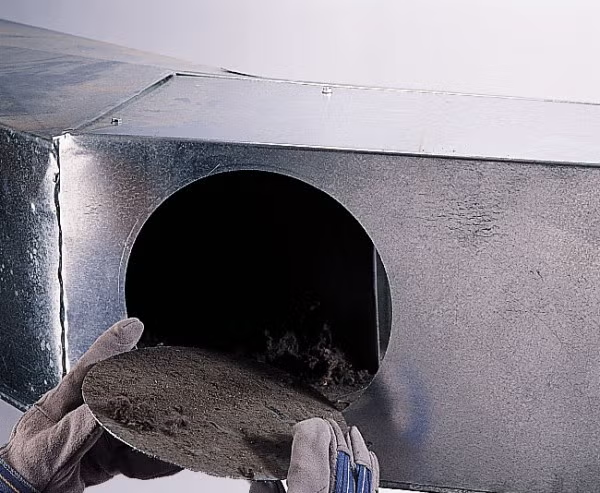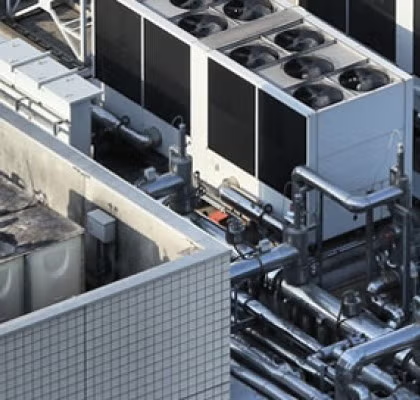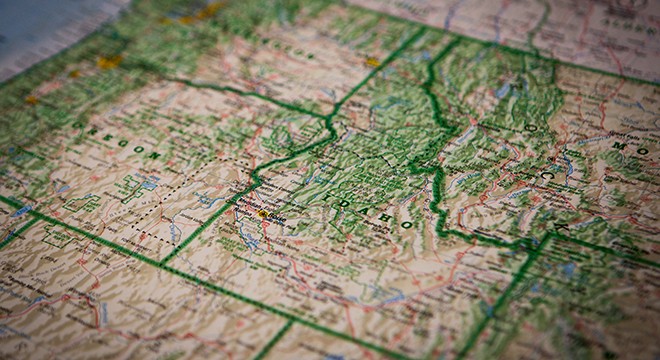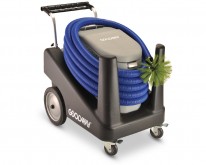Cleaning Ducts and Ventilation Systems

Hardly a week goes by without hearing, or seeing something concerning "indoor air quality" (IAQ), or "sick building syndrome" (SBS). What was once thought to be imagined maladies are now known to be attributed to the air we breath indoors. 28% of all humans suffer from allergies; 1 in 6 of whom do so as a direct result of dirty duct systems. In fact, as many as half of all illnesses are either caused, or aggravated by indoor air pollution. According to the EPA, indoor air can be up to 70 times more polluted than outdoor air.
What causes IAQ problems? Almost 80% of IAQ problems are caused by either inadequate ventilation, a source of pollution, or both. Inadequate ventilation is usually pretty straightforward to fix. A pollution source can be external to the building, or within the building itself (including the ventilation system duct work). Building operations personnel have little, or no control over external pollution sources and usually must resort to special filters, or other solutions. Internal pollution is a little easier to deal with, especially a contaminated duct system.
Building operations personnel have three choices when a contaminated duct system is discovered:
- Ignore the problem.
- Hire a duct cleaning contractor at a considerable expense.
- Acquire the necessary equipment and training to perform duct cleaning in-house.
Ignoring the problem is foolish given the litigious nature of the times in which we live. No building owner wants a lawsuit over a situation that could have been addressed and corrected.
Hiring a duct cleaning contractor may, or may not, be the most cost-effective solution. Factors to consider are the size of the ventilation system, the expected frequency that the system will need to repeat cleanings, staffing size and capabilities, etc. If the decision is made to hire a contractor, a careful selection process must be followed to ensure that the work is done by a well qualified, experienced and professional contractor. Unfortunately, there are still some contractors out there that utilize outdated, or shoddy duct cleaning methods that can often leave a problem worse than it was before they "cleaned" the system.
There are many cases where in-house duct cleaning is the most cost effective choice. In addition to cost savings, in-house cleaning keeps control of the quality of work with the operation's personnel. One area where this is easily justified is in health care facilities - hospitals, nursing homes, clinics and so on. Protection of the patient is top priority here and maintaining clean indoor air can be a major contributing factor towards this goal.
Another area for in-house ventilation system maintenance is educational facilities - colleges, universities and school districts. America's students are the future and every precaution should be taken to contribute to a healthy learning environment.
In all cases, outdoor air quality has to be taken into consideration when planning ventilation system maintenance. Remember, the dirtier the air is outside, the faster the duct system can become contaminated and require cleaning.
DUCT CLEANING IN THE HEALTH CARE FACILITY AND EDUCATIONAL INSTITUTION
In addition to normal contaminants, such as dust, lint, mold spores and fungi, health care facilities have the added problem of viral and bacterial contamination. Areas of particular concern are operating rooms, intensive care units, pediatric wards and geriatric wards. Elderly people often suffer with breathing problems and polluted indoor air only intensifies their problems. The same holds true for asthmatics.
Children are particularly affected by indoor air pollution because they breathe more air that adults. The average adult breathes 16,000 quarts of air a day. Because children breathe faster, they breathe more air after taking body weight into account. Where is there a higher concentration of children than in our nationメs schools? In addition to health concerns, poor indoor air quality can contribute to fatigue or restlessness that can effect student productivity in class.
DUCT CLEANING EQUIPMENT
VACUUMS
Contrary to popular belief, it is not necessary to own a giant truck mounted vacuum to perform professional quality duct cleaning. In fact, in larger buildings it is imperative to use portable equipment in order to gain access to all cleaning locations. Truck mounted duct vacuums are more suitable to residential work. Two types of vacuums are required for successful duct cleaning. First is a large HEPA filter equipped negative air machine generating at least 4000 CFM. This unit is connected directly to the duct and maintains the section being cleaned under negative pressure to prevent contamination of the occupied space. It also collects all debris loosened in the cleaning process. A portable HEPA vacuum should also be on hand for contact vacuuming of turning vanes, plenums, coils, drip pans, registers, and other surfaces.
AGITATION DEVICES
There are three basic accepted agitation devices available for disturbing contaminants and sending them into the airstream created by the negative air machine. First, there is manual agitation by means of contact vacuuming. This method requires physical access to all surfaces either by reaching through access openings or physically entering the duct system. Next, there are a variety of air nozzles used to blow the contaminants off the duct surfaces. They require the purchase of a portable air compressor in addition to other equipment. Because they do not make contact with 100% of the inner surfaces, there can be doubts as to whether all surfaces were cleaned. The third agitation device in use is the rotary brush device. These consist of a brush or other cleaning device spinning on the end of a motor driven shaft. In most cases, a flexible shaft is used for ease of operation and to accommodate turns in the ducts themselves. Many duct cleaning jobs require the use of more than one technique.
PRESSURE WASHERS
It is helpful to have a small portable pressure washer that generates 500 PSI on hand. This unit is used to clean the coils and drip pans in the system.
ACCESS AND PATCHING TOOLS
Access openings are made using tin snips, hole cutters or other devices. When finished, access openings can be patched using reusable doors or with sheet metal, screws, duct tape, and sealants.
SAFETY EQUIPMENT
Safety equipment includes scaffolds and work platforms (working from ladders can be dangerous), lockout/tagout equipment, eye protection, breathing protection and cut resistant gloves.
PLANNING THE JOB
The first thing needed to plan a duct cleaning job is accurate mechanical drawings of the duct system. This is used as both a planning tool and a road map during the actual job. They make it possible to identify coils, turning vanes, access points and other important information. Duct cleaning is generally performed in sections of about 25 feet or less. These "cleaning zones" should be identified on the drawings when planning the job. Uncleanable types of duct should also be identified at this time and plans for removal and replacement made. Most flexible duct and certain lined duct work cannot be cleaned without damaging the ducting.
A cleaning schedule must also be established to ensure that all duct cleaning is performed in unoccupied areas.
SYSTEM INSPECTION
Before cleaning is performed, the duct system must be inspected to identify any access problems or any damaged or contaminated porous materials which will require replacement. General structural condition of the system can also be assessed at this time. All inspection activities should be performed when the inspection area is unoccupied and the HVAC system is shut off. Use drop cloths to protect furnishings in the occupied space.
DOING THE JOB
Before beginning any duct cleaning job, the HVAC system must be shut off and locked out using approved lockout/tagout procedures. Drop cloths should again be used to protect the occupied space. The return side of the system is always cleaned first. The return side can typically be 5 to 10 times as dirty as the supply side.
Starting at the return air and outdoor air intakes, sections of duct are cleaned moving toward the main air handler. Sections of ductwork can be isolated for cleaning by inserting inflatable bladders in the duct and inflating them to block the duct off. Cleaned sections can be isolated in this way to prevent recontamination. An access opening should be made in the duct if one does not currently exist. Another opening is needed further downstream for connection of the HEPA filter equipped negative air machine. Typically, the distance between openings is 25 feet or less. With the negative air unit running, the cleaning tool is inserted into the duct and fed in the direction of the airstream. Some of the rotary brush type cleaners available can be fitted with a fan-like brushing tool that actually blows the debris toward the vacuum source. Care must be exercised when using a rotary brush in lined duct not to allow the brush to remain in one spot for too long. Close attention should be paid to cleaning fire dampers and turning vanes as greater deposits are often found in these areas.
Once the return side has been completed, the supply side of the system is cleaned using the same techniques. Access openings should be closed with reusable doors or air tight patches as the work moves along. Any disturbed insulation must be repaired as well. Grills and registers can be removed and pressure washed or vacuumed with the portable HEPA vacuum.
Particular attention should also be given to heating and cooling coils and drip pans. These are prime breeding grounds for microbial contamination and, if left uncleaned, will recontaminate the newly cleaned ducts. Coils and drip pans are best cleaned using the portable pressure washer and portable HEPA vacuum. At this time, drip pans should be checked for proper drainage and drainage systems freed of any obstructions.
Once the cleaning is completed and all access points resealed, a final inspection should be performed. Once the system is started up, it should be allowed to run until 8 complete air changes have occurred before the area is reoccupied.
Also, consideration should be given to the installation of more efficient filters on the HVAC system to reduce future contamination.
OTHER BENEFITS OF CLEAN DUCTS
Besides the obvious health benefits derived from cleaning HVAC systems, here are some other benefits:
- Increased employee productivity - healthier people make better workers and lose less time to sickness.
- Reduced housekeeping costs - the HVAC system is not pumping dirty air into the occupied space.
- Increased airflow - because air moves unobstructed by debris build up, blowers and fans do not need to cycle as long or as often.
- Energy savings - because motors and drives do not work as hard, less energy is consumed by the system.
SOME OTHER AREAS TO CONSIDER DUCT CLEANING
In addition to ventilation system cleaning, here are some other areas to consider for regular inspection and cleaning:
- Dryer vents in laundry areas. Cleaning dryer vents reduces fire risk.
- Ventilation vents of all kinds.




